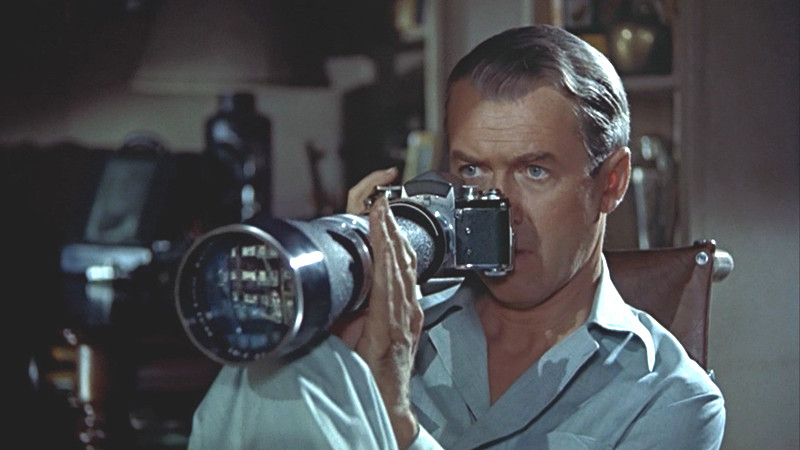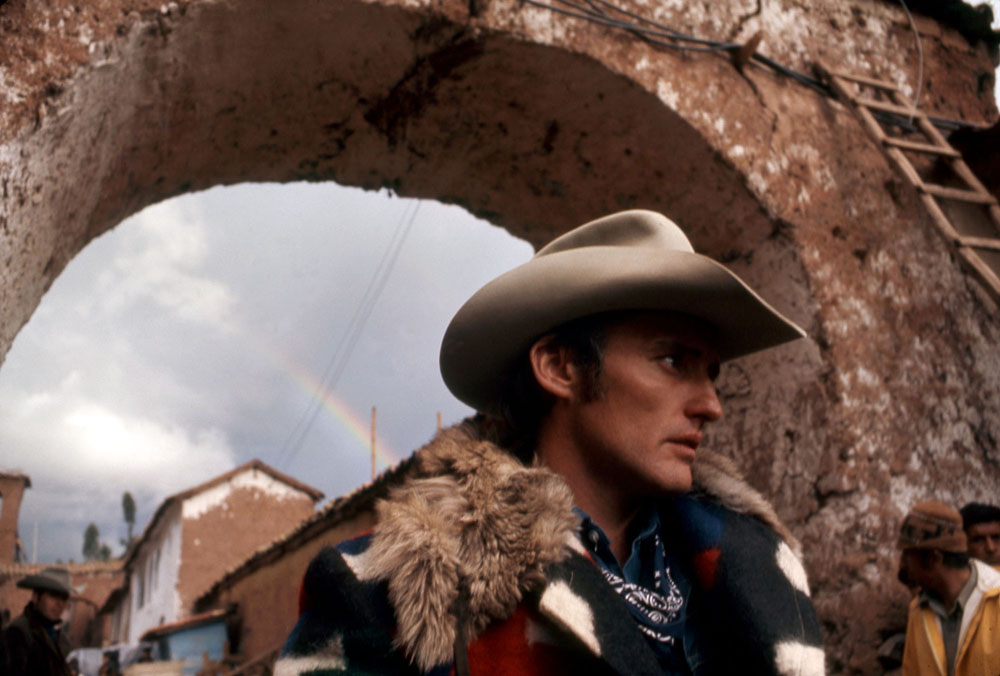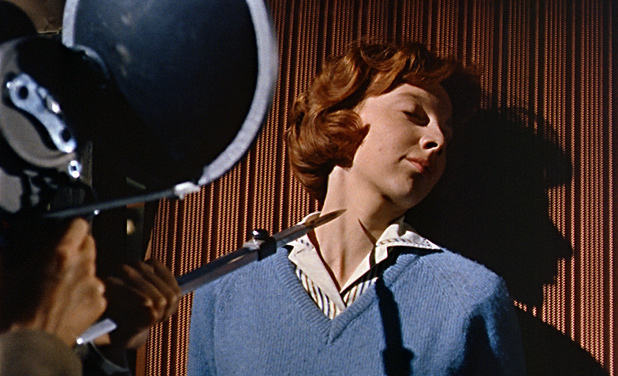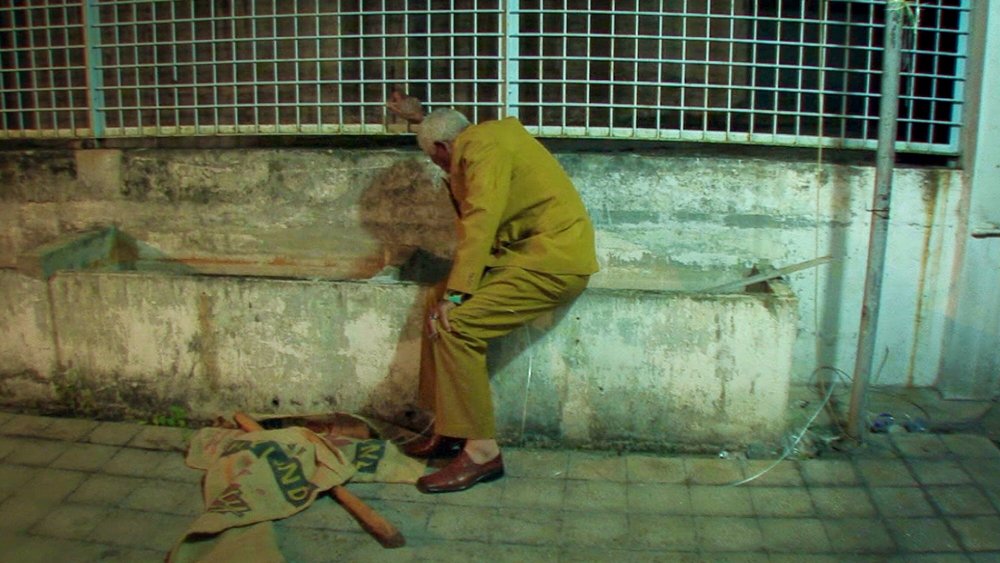5. Rear Window (1954)

A favourite among film theorists, Rear Window isn’t an immediate contender to be a so-called ‘film about film.’ The story follows L.B. Jeffries, an action-photographer confined to a wheelchair and his New York apartment during one oppressively hot summer, as he watches his neighbours from across the courtyard through his telephoto lens. However, as the summer drags on, Jeffries becomes convinced that the man in the apartment across from his, Lars Thorwald, has murdered his wife. Unable to move beyond the boundaries of his apartment in his wheelchair, Jeffries relies on those around him to help him solve the case, whilst he watches, always watching.
Jeffries is an impotent presence on the screen. In a literal manner, he’s bound to his wheelchair and incapable of much action, but he’s also impotent in another sense. His girlfriend is Lisa, played by the incomparable Grace Kelly, looking as dazzling and beautiful as anyone to have ever graced the silver screen. Lisa is keen to marry Jeffries, but he wants nothing of it. In fact, he seems to want nothing to do with her. Every ounce of affection Lisa pours on Jeffries is treated with annoyance and derision, and it’s only after Lisa’s life is endangered that Jeffries starts to fall for her again. To help him catch the killer, Lisa goes over to Lars’ apartment whilst he’s not home… only Lars returns to find her, and it’s a miracle that she manages to escape unharmed. Only after this incident does Jeffries begin to show anything like love and admiration towards his devoted girl. As she came face to face with this killer, Jeffries was watching all along.
The reason Rear Window is a favourite among film scholars- it must be up there with Vertigo and Citizen Kane as one of the most written about films in the history of the movies- is what we can read from the film theoretically. As Jeffries watches the narratives of his neighbours’ lives play out from the safety of his apartment, he represents us, intrusively watching the lives of others up on a screen from the safety of a darkened theatre.
The idea that filmmaking and film-viewing is akin to a kind of voyeurism is a well-trodden concept in film criticism. Whether Hitchcock intended this reading for his film is unclear. Frankly, it doesn’t matter. We can still read so much from Rear Window and apply it to our own lives. Whilst playing a photojournalist who does venture the world looking for the next shot (the reason he’s confined to a wheelchair, after all, is because he was daring enough to get the perfect action shot and paid a heavy price for it), Jeffries nevertheless represents the cinephile in Rear Window. He’s someone who’s more interested in fantasy than reality, more interested in watching other people’s lives than living his own, more comfortable watching than doing. (Even with an impatient Grace Kelly stood behind him, tutting.)
As well as being a near-perfect thriller, Rear Window packs a number of themes that tells us something about cinema: voyeurism, scopopillia, the male gaze… We cinephiles may like to picture ourselves as the hero of our stories, but perhaps the main thing to take away from Rear Window is that no matter how much we want to believe we’re watching alone, we can’t watch forever without hurting those around us.
6. The Last Movie (1971)

You’d be forgiven for not having seen The Last Movie. It’s perhaps most famous for being the film that led to director Dennis Hopper’s self-imposed exile from Hollywood after the negative vitriol his daring film endured. Indeed, after the earlier success of Easy Rider, studio executives didn’t quite know what to do with Hopper’s new film. Instead of championing it as a insightful critique of the neocolonialist logic of the American film industry, Universal Pictures buried the picture, giving it a weak, staggered release, and thus ruining any chance of this dangerous film reaching a mass audience and allowing that audience to question whether the studio system was in fact complicit in the fantasies and realities of racial violence and exploitation. Shock horror.
Hopper stars as Kansas, a stuntman filming a Western in a rural Peruvian village. After a violent incident on the fictitious set, Kansas quits the movie business to live a life among the Peruvian people, only to see those villagers reenact the violence they learnt from the American movie. No doubt inspired by the French New Wave films of the previous decade, The Last Movie draws attention to the fact that it is a movie, with a non-linear narrative, rough edits and, most famously, a ‘Scene Missing’ title card jolting whatever narrative flow the film otherwise offered audiences. Such stylistic choices, as with Persona and many other self-aware films, allow the audience to question the meaning of what they are watching, as Brecht allowed his audience to do in the theatres of Berlin decades earlier. So what exactly is The Last Movie trying to tell us?
What The Last Movie tells us is that movies can be dangerous. The Hollywood film- characterised by the Western genre- represents a wider American culture, one built on expansionism, exploitation and violence. The logic of these characteristics feeds its way into the culture industry, which in turn feeds its way into everyday viewers, as shown in the film through the violence reenacted among the indigenous Peruvian villagers.The fact that the film being shot within Hopper’s film is a Western is of course significant, signifying the legacy of earlier colonial violence and America’s expansionist logic.
Far from being a typical Western mainstream audiences had grown used to in 1971, The Last Movie radically critiqued the film industry and the capitalist system it relies on, a system which in turn relies on exploitation, appropriation and violence. Hopper made a radical, critical and self-aware film, challenging the power relations embedded within the culture industry, and in turn asked audiences to question the destructive effects such a culture has on both those who pay to see it and those that system exploits. The result? Hollywood effectively silenced the film, and Hopper was left out of mainstream circles for years to come. Some things never change.
7. Peeping Tom (1960)

The story is one that could only work onscreen. Carl Boehm plays Mark Lewis, a photographer and aspiring filmmaker, who also happens to murder women, recording his victims’ final expressions with his camera. His murder weapon? A blade attached to the leg of his tripod. His method of killing and recording are one and the same. Should we be proud to call ourselves cinephiles?
Michael Powell’s film certainly shocked and appalled when it opened in 1960; supposedly because of its graphic depiction of sexuality and violence, though one wonders whether it was the dark questions of complicity raised- questions some film-goers would rather keep hidden- that was the real reason the film offended the way it did. Indeed, after a stellar career, directing such classics as The Life and Death of Colonel Blimp (1943), A Matter of Life and Death (1954) and The Red Shoes (1948) among others, the reaction to Peeping Tom seriously wounded Powell’s career, inflicting a violence from which it never fully recovered. The victims of the movies aren’t always onscreen.
Like Rear Window, the film bluntly deals with voyeurism. The difference here, however, is the level of viciousness. For all his voyeuristic intrusiveness, Rear Window’s Jeffries is ultimately an impotent character. It’s his voyeurism that detects someone else’s crime, and it’s the people around him who do more to solve it. In Peeping Tom, voyeurism is married to violence. (Powell and Hitchcock are certainly cinematic brethren; their films explore similar areas, and Powell worked on several of Hitch’s films early in their careers.)
Peeping Tom deals with a smörgåsbord of cinematic themes: voyeurism, sadomasochism, scopophilic fetishism- all themes inherently tied up into the ontology of cinema, the moving image and the act of watching. American critic Roger Ebert summed it up best, reminding us that “the movies make us into voyeurs. We sit in the ark, watching other people’s lives. It is the bargain the cinema strikes with us, although most films are too well-behaved to mention it.” Peeping Tom is not well-behaved, and Powell’s career paid the ultimate price for it. But it fiercely demonstrates the dangerous nature of cinema- both in the act of recording and in the act of viewing. Cinema is a dangerous art. And whilst we may not be killers, we are all of us watchers.
8. Stories We Tell (2012)

In the short time since its release in 2012, Stories We Tell has cemented itself as one of the most important documentaries of the 21st century and secured a regular spot on undergraduate viewing lists. The film, written and directed by Sarah Polley, explores Polley’s own family history. Specifically, it looks at the relationship between her mother and father, Diane and Michael Polley, and the Montreal producer Harry Gulkin, who we learn partway through the film had an affair with Diane and is actually the filmmaker’s biological father.
As well as the melodramatic facts of this family drama, the most striking aspect of this film is the way it’s presented to us. Along with present day shots of Polley constructing the film, interviewing family members and friends, each with their own unique version of the past, Stories We Tell is also made up of old family movies: Super-8 footage, seemingly picked from hours and hours of existing material. It seems like every major event of Polley’s parents’ life was documented on film, so much so that we start to question whether it can really all be true… until we learn it’s not.
At the film’s close, we see that much of this ‘home footage’ was in fact actors portraying Polley’s parents in the style of Super-8 movies, thus bringing into question film’s role as an objective harbinger of truth and a reliable account of the past. (Polley estimates between thirty and fifty percent of the film’s footage used in the final cut to be authentic.) In addition to this footage, Stories We Tell also uses clips from cinema history- most humorously a dissection of Marriage Italian Style- to help illustrate the moving image’s power to serve a narrative, and its vulnerability for cooption to serve ends different from those its makers originally intended.
In an interview, Polley said “I wanted to be open about the fact that the film is a construction; the idea was to provide audiences with that experience and make them wonder what is real (and what they can hang on to) and what is manufactured and manipulated. The idea was to construct something from the past while also calling that entire process of construction into question.” Even if the Super-8 footage were authentic, would it bring us much closer to anything resembling a universal truth? Probably not. Instead, this final act reveal cements the key themes of the film: not so much the specifics of personal biography, but instead the unreliability of memory, the danger of constructing narratives based on subjective truths, and film’s role in the construction of those narratives.
Although Polley’s film is purely personal, it’s not hard to draw out the political implications of Stories We Tell. In the same interview, Polley said she was interested in “the idea of constantly wondering what was real and what was not, what was nostalgia, what was fact.” If film can be manipulated in the service of one’s own narrative, be it the faked Super-8 footage or the re-used clips from Marriage Italian Style, then it can be manipulated and make one question what is fact and what is not.
The debate over whether the photographed image accurately reflects reality is a debate that goes back to some of the earliest critics and commentators on both film and, before it, the revolutionary art of photography. We don’t have to think hard to consider the myriad ways film footage can be appropriated and used to serve a particular, perhaps sinister, end. Again, Polley comments that “people’s desire to believe what they’re seeing is so strong.” This is both true in the darkened cinema and in wider society, where fake news, misleading headlines and misinformation all vie for our attention in the mad cacophony of the present day media landscape.
Stories We Tell tells us a lot. It tells us about the vulnerability of memory and the difference between objective and subjective truth. Going forward, we’re all going to have to do better to spot the difference. Perhaps the best thing we can learn from Polley’s film is how to be better viewers.
9. The Act of Killing (2012)

Like Stories We Tell, The Act of Killing is a documentary released in 2012, but whereas Stories takes an inward, microscopic look at one family, Killing looks outward. The Danish-British-Norwegian co-production, directed by Joshua Oppenheimer, Christine Cynn and anonymous, explores the Indonesian mass killings of 1965 to 1966. This film and Stories We Tell also both look backwards, using film as a means of examining memory and the past, but The Act of Killing is unique in its use of cinema as a method of exploring historic atrocities and personal guilt- a method that has attracted international praise as well as staunch criticism.
This distinctive method of examining the past is the reason The Act of Killing is so famous. Rather than using the conventional tools of documentary- a combination of archival footage and personal interviews to piece together the objective facts of the past- Oppenheimer and his crew instead give several of the real-life perpetrators of the mass killings video cameras and recording equipment, and ask them to reenact their recollections of their actions during the genocide. Rather than shamefully denying any participation or wrongdoing, these men not only perform their violent crimes but do so with a flourish.
Sets and make-up are used to heighten their version of the past, a version that does not deny their past violence but instead boasts about it in the artistic style of a forgotten B-movie. To add even more discomfort to this horrific premise, the films the perpetrators end up making largely mirror their favourite Hollywood genres, namely the musical, the Western and the gangster movie. The cheap aesthetics these men dress their versions of the past with add a chilling edge to what is undoubtedly one of the most important films ever made, one that uses cinema itself to explore memory, guilt and the banality of evil.
Like the best works of political theory, The Act of Killing forces us to question straightforward notions of good and evil. The line between the two is not simple and concrete, and this can make for uncomfortable viewing. Shocking are the scenes where these war criminals seem to realise the weight of their crimes in their reenactment and start to express what looks something like guilt. More shocking are the scenes where this guilt is not forthcoming.